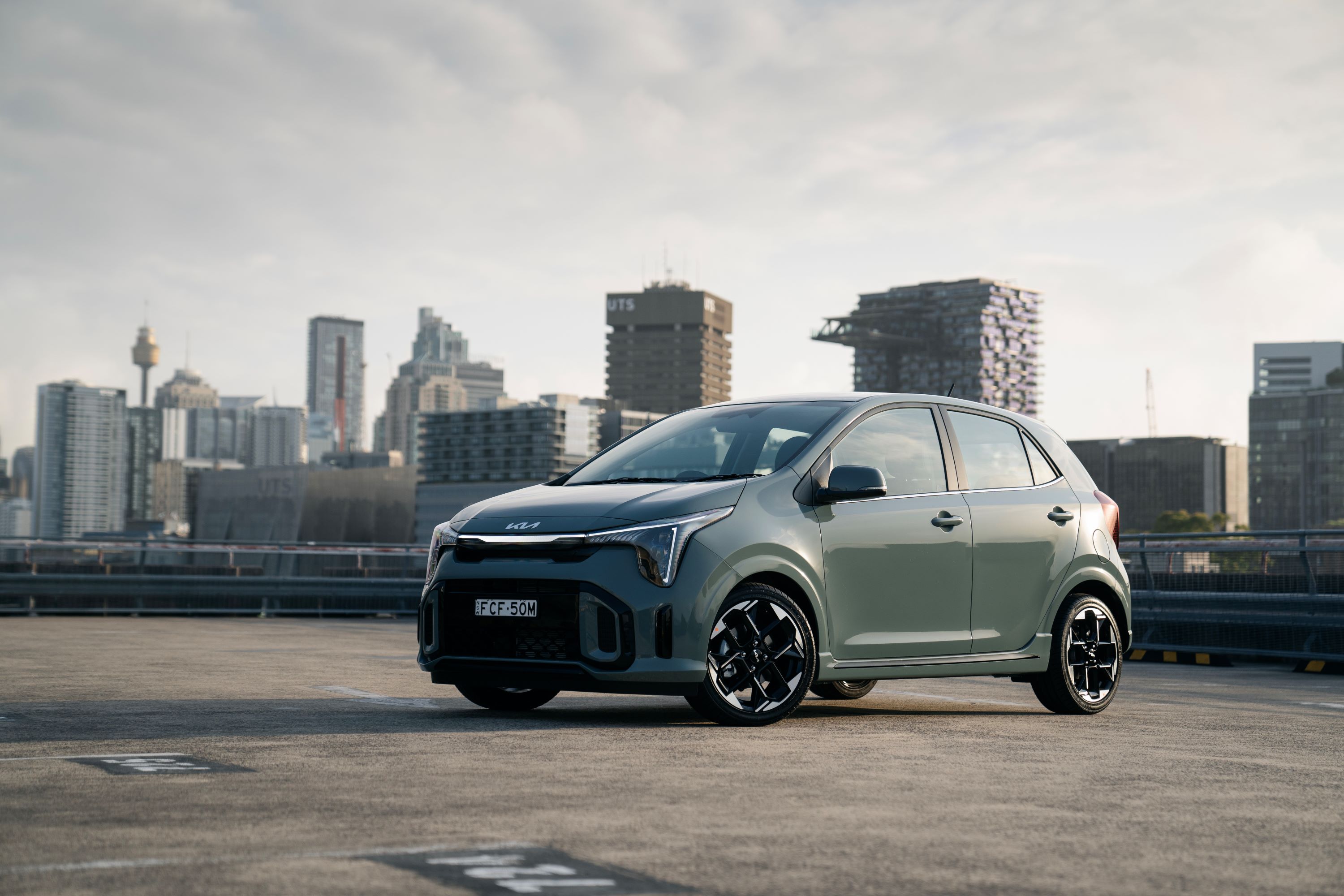
While the battle rages for the high ground of the top tech, and expensive, electrified territory of the automotive world, a rear-guard action from the internal combustion engine bargain basement is taking place.
Micro cars such as the MG 3, Suzuki Ignis, Fiat 500 and Mazda 2 are leading the charge to defend ICE(land). The latest call to arms comes from Kia with its upgraded Picanto. What are its chances?
Sadly, gone ta-taas is the popular GT, replaced by a pair of GT-Line legionnaires. Kia says it has called on the company’s footy-like ‘Opposites United’ (How do they think of ’em?) philosophy for the new range, leading to a modern, sporty design highlighted by a new headlamp set-up, ‘ripped’ radiator grille and reshaped front bumper.
Out back, the tail lamps and bumper have been tweaked.
The new Picanto comes in two trim levels – Sport and GT-Line – with prices coming in at $17,890, plus on-road costs, for the entry-level five-speed manual. The four-speed automatic sells for $19,490, while the flagship GT-Line auto tops out the range at $21,290. On test was the latter.
Price is not the only selling point, For Picanto buyers it’s welcome to Kia ‘seventh heaven’ with the maker’s class-leading seven-year warranty and capped price servicing at 12-month intervals, plus up to eight years roadside assist.
STYLING
On GT-Line, further from above, a daytime running light strip extends across the leading edge of the bonnet, pushing out the headlamps with emphasis on the width.
Newly designed wheels – 14-inch alloys on the Sport and a 16-inch machine finished diamond cut quartet for the GT-Line.
Power folding side mirrors with integrated warning indicators are now standard across both trims, with GT-Line boasting heating too. Seven exterior paint finishes are on offer, with Adventurous Green being new to Kia.
INTERIOR
Premium leatherette features as standard on steering wheel and gearshift knob across the range, with the latter also scoring a D-cut sports steering wheel. Leg room, especially in the back is at a premium, while head room is not so.
The driver’s side footwell is not welcoming to larger feet. Pedal space is cramped. Keyless entry is tainted by the need to use it the steering column lock to start the motor.
Boot space, with rear seat backs up is briefcase-like 255 litres; with the seat backs folded, a respectable 1010 mm.
INFOTAINMENT
Gone are the analogue gauges, replaced by a 4.2-inch digital instrument cluster, making the perfect match for the carry-over 8-inch touchscreen – with Apple CarPlay and Android Auto – perched atop the central dashboard, beneath which are air-con (no climate) controls with easy-to-operate large knobs.
GT-Line rear occupants also benefit from the addition of USB-C charging ports.
.
ENGINES / TRANSMISSIONS
Nothing (new) to see here – the Picanto carries over the existing 1.2-litre MPI non-turbo engine, mated with either five-speed manual or four-speed automatic transmission, putting power to the ground through the front wheels.
SAFETY
With young drivers in mind, the Picanto GT-Line is equipped with a range of Kia’s Advanced Driver Assistance Systems as standard across both trims. These include blind spot collision avoidance Assist rear BCA, rear cross-traffic collision avoidance assist, and lane follow and lane keeping assist.
difference in performance between the former 1-litre three-cylinder motor and the carry-over four-cylinder unit. Low on torque, the GT-Line auto is in no rush to get going, nor is it up There’s a reversing camera and rear parking sensors but nothing at the front, which is a pity because of the stubby nose.
Passive safety is in the hands of six airbags – dual front, front side and full-length curtain.
DRIVING
There appears to be little for smart overtaking while on the run. Tootling around town is more to its liking.
The maker puts the fuel consumption on the combined urban / highway cycle at 6 litres per hundred kilmetres. Over a week of average work the test vehicle recorded 7.1 k\litres per 100 kilometres.
The ride and handling were reasonably comfortable – some bumps and lumps along the way, considering the short wheelbase (2400 mm) and steering came up with good reaction to driver input.
Feedback was solid but the tyres could not avoid chiming in with annoying road noise on course surfaces. However, the Picanto gets a ‘gold medal’ for parking. Pick a spot – almost any spot – and the compact is quick to reward the driver in forward or reverse.
SUMMARY
Kia lines up its Picanto to broaden the appeal of its mini hatchback, sacrificing its popular GT in the move.
RATINGS
Looks – 8
Performance – 4
Safety – 6
Thirst – 7
Practicality – 7
Comfort – 5
Tech – 7
Value – 8
AT A GLANCE
MODEL LINE-UP
Kia Picanto Sport manual $17,890
Kia Picanto Sport automatic $19,490
Kia Picanto GT-Line manual $19,690
Kia Picanto GT-Line automatic $21,290
Note: These prices do not include government or dealer delivery charges. Contact your local Kia dealer for drive-away prices.
SPECIFICATIONS (Kia Picanto GT-Line 1.2-litre 4-cyl petrol, 4sp auto, FWD)
ENGINE
Configuration: four cylinders inline
Maximum power 62 kW
Maximum torque: 122 Nm
Fuel type: Petrol 91 RON
Combined fuel cycle: (ADR 81/02) 6.0 L/100km
DRIVELINE: Four-speed automatic, front-wheel drive
DIMENSIONS, WEIGHT, AND CAPACITIES
Length: 3595 mm
Width: 1595 mm
Height:1485 mm
Wheelbase:2400 mm:
Turning circle: 9.4 metres
BRAKES
Front: Ventilated disc
Rear: Disc
STANDARD WARRANTY
Seven years / unlimited kilometres